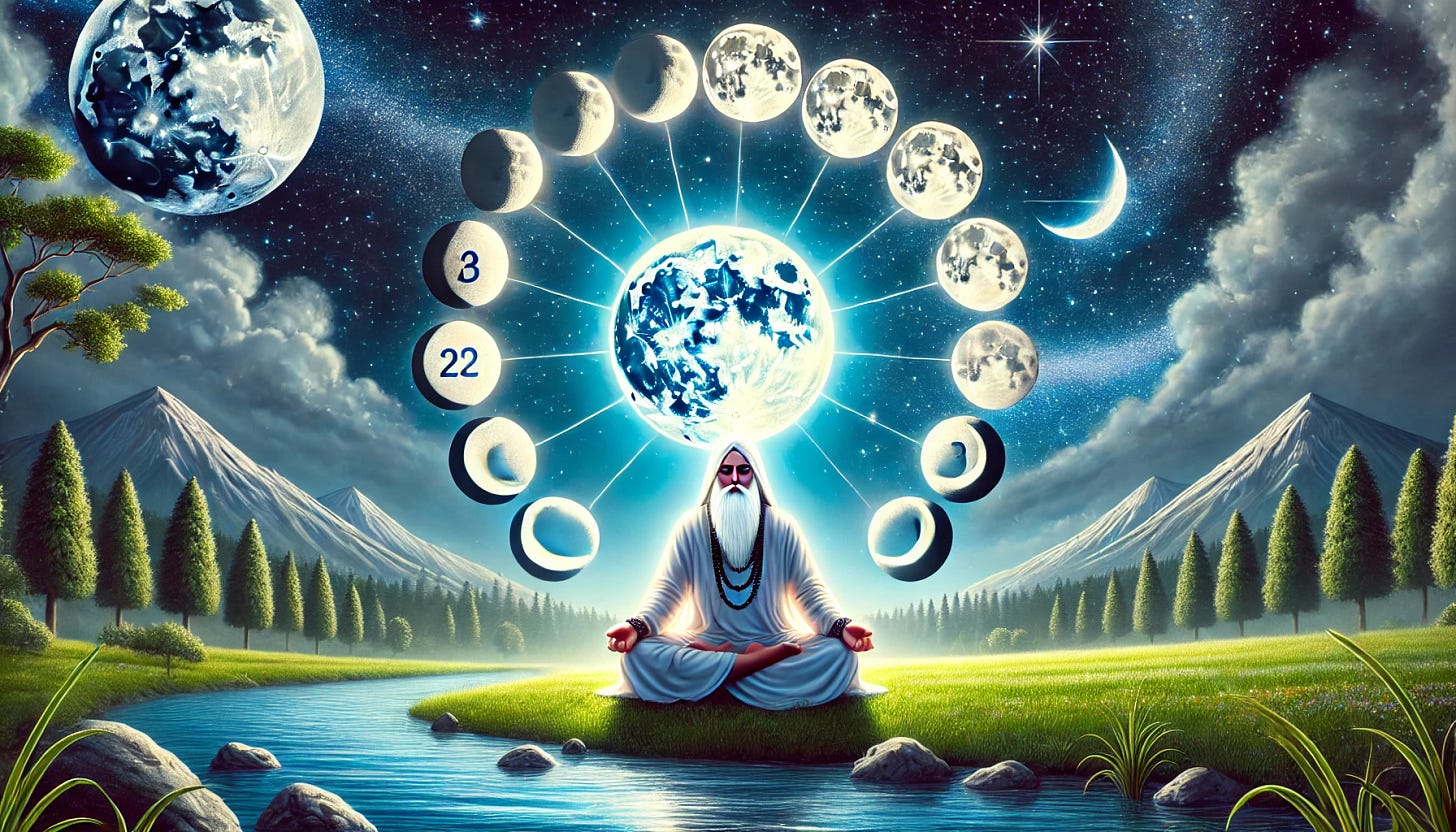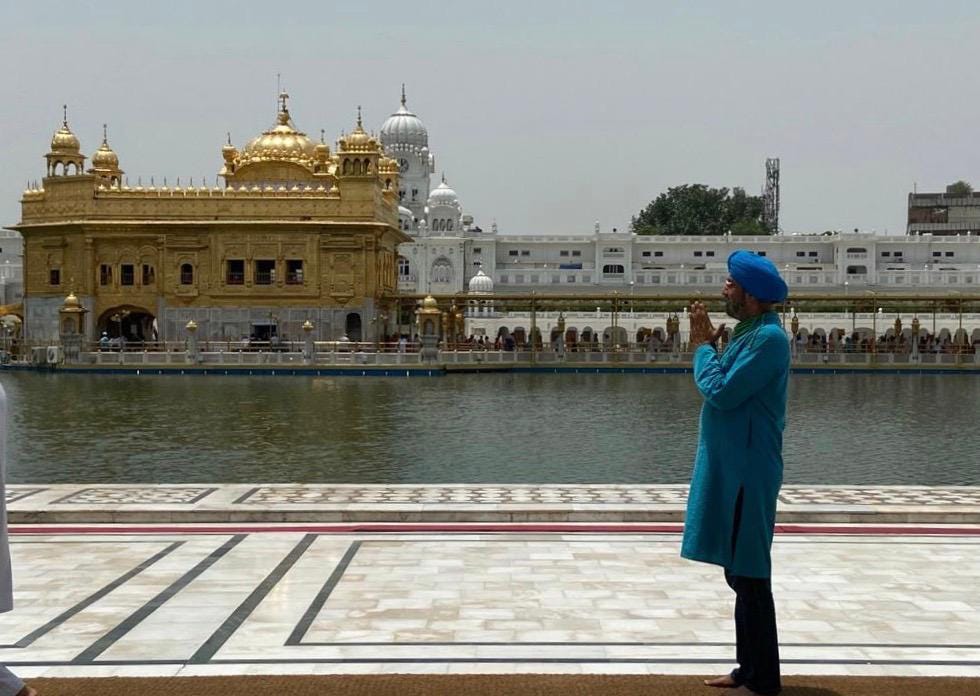Phases of Moon in Sri Guru Granth Sahib
The Divine Wisdom of Bhagat Kabir Ji: A Journey Through the 15 Phases of the Moon.
A Divine Journey Through the 15 Phases of the Moon
The verses of Bhagat Kabir Ji, enshrined in Sri Guru Granth Sahib (Angs 343-344), offer profound spiritual insights through the metaphor of the fifteen lunar phases. These sacred verses delve into the waxing and waning of the moon, symbolizing the transient nature of human existence and the spiritual journey of the soul. Each phase of the moon corresponds to a unique spiritual teaching, guiding the seeker toward self-realization and union with the Divine.
While the moon changes constantly, reflecting the impermanence of worldly life, the Creator stands as the eternal and unchanging truth. Bhagat Kabir Ji's reflections inspire the seeker to rise above the illusions of change and instability, embracing the steady and immortal essence of God. Through meditation, wisdom, and the grace of the Divine, one can transcend impermanence and find eternal peace in the presence of the Creator. These verses serve as a timeless reminder of the ultimate goal: to recognize and merge with the One who remains unaltered, from the beginning to the end.
Below is a reasonably detailed exposition of the Shabad, covering each lunar phase with Gurmukhi, Roman transliteration, and English translation. Each phase is explored in depth, with its message unified in one paragraph.
0. Amavas (New Moon)
ਅੰਮਾਵਸ ਮਹਿ ਆਸ ਨਿਵਾਰਹੁ ॥ ਅੰਤਰਜਾਮੀ ਰਾਮੁ ਸਮਾਰਹੁ ॥ ਜੀਵਤ ਪਾਵਹੁ ਮੋਖ ਦੁਆਰ ॥ ਅਨਭਉ ਸਬਦੁ ਤਤੁ ਨਿਜੁ ਸਾਰ ॥੧॥
Ammaavas mehi aas nivaarahu. Antarjaamee raam samaarahu. Jeevat paavahu mokh duaar. Anbhao sabad tat nij saar. ||1||
On the day of the new moon, give up your hopes. Remember the Lord, the Inner-knower of hearts. While living, find the door to liberation. Realize the fearless Word and the essence of your true self. ||1||
Interpretation: The dark night of Amavas symbolizes detachment from worldly hopes. By meditating on the Fearless Lord, one attains liberation in this very life and connects with their innermost essence.
1. Pratipada (First Lunar Day)
ਪਰਿਵਾ ਪ੍ਰੀਤਮ ਕਰਹੁ ਬੀਚਾਰ ॥ ਘਟ ਮਹਿ ਖੇਲੈ ਅਘਟ ਅਪਾਰ ॥ ਕਾਲ ਕਲਪਨਾ ਕਦੇ ਨ ਖਾਇ ॥ ਆਦਿ ਪੁਰਖ ਮਹਿ ਰਹੈ ਸਮਾਇ ॥੨॥
Parivaa pareetam karahu beechaar. Ghat mehi khelai aghat apaar. Kaal kalpanaa kade na khaai. Aad purakh mehi rahai samaai. ||2||
On the first day of the lunar cycle, contemplate the Beloved Lord. The Infinite One plays within the body. Death does not affect those absorbed in the Primal Lord. ||2||
Interpretation: Reflecting on the Lord's infinite presence within helps the seeker transcend the fear of death and merge into the Eternal One.
2. Dwitiya (Second Lunar Day)
ਦੁਤੀਆ ਦੁਹ ਕਰਿ ਜਾਨੈ ਅੰਗ ॥ ਮਾਇਆ ਬ੍ਰਹਮ ਰਮੈ ਸਭ ਸੰਗ ॥ ਨਾ ਓਹੁ ਬਢੈ ਨ ਘਟਤਾ ਜਾਇ ॥ ਅਕੁਲ ਨਿਰੰਜਨ ਏਕੈ ਭਾਇ ॥੩॥
Dutiyaa duh kar jaanai ang. Maya brahm ramai sabh sang. Naa ohu badhai na ghattaa jaai. Akul niranjan ekai bhaai. ||3||
On the second day, recognize duality—Maya and Brahm are present everywhere. Yet God neither increases nor decreases. He is unknowable and immaculate, united in love. ||3||
Interpretation: Awareness of duality helps transcend illusion, connecting the seeker with the One who is beyond all change.
3. Tritiya (Third Lunar Day)
ਤ੍ਰਿਤੀਆ ਤੀਨੇ ਸਮ ਕਰਿ ਲਿਆਵੈ ॥ ਆਨਦ ਮੂਲ ਪਰਮ ਪਦੁ ਪਾਵੈ ॥ ਸਾਧਸੰਗਤਿ ਉਪਜੈ ਬਿਸ੍ਵਾਸ ॥ ਬਾਹਰਿ ਭੀਤਰਿ ਸਦਾ ਪ੍ਰਗਾਸ ॥੪॥
Tritiyaa teene sam kar liaavai. Aanand mool param pad paavai. Saadh sangat upjai bisvaas. Baahar bheetar sadaa pragaas. ||4||
On the third day, balance the three qualities of nature. In doing so, the source of bliss and the supreme state is attained. In the Company of the Holy, faith arises, and God’s Light shines within and without. ||4||
Interpretation: By harmonizing life’s polarities and seeking holy company, one experiences divine illumination and eternal joy.
4. Chaturthi (Fourth Lunar Day)
ਚਉਥਹਿ ਚੰਚਲ ਮਨ ਕਉ ਗਹਹੁ ॥ ਕਾਮ ਕ੍ਰੋਧ ਸੰਗਿ ਕਬਹੁ ਨ ਬਹਹੁ ॥ ਜਲ ਥਲ ਮਾਹੇ ਆਪਹਿ ਆਪ ॥ ਆਪੈ ਜਪਹੁ ਆਪਨਾ ਜਾਪ ॥੫॥
Chaothahi chanchal man kau gahhu. Kaam krodh sang kabahu na bahhu. Jal thal maahe aapeh aap. Aapai japahu aapnaa jaap. ||5||
On the fourth day, restrain the fickle mind. Do not associate with lust and anger. God exists in water, land, and everywhere. Meditate on His Name, for He Himself is the mantra. ||5||
Interpretation: Restraining the mind and renouncing negative tendencies leads to experiencing God’s presence everywhere.
5. Panchami (Fifth Lunar Day)
ਪਾਂਚੈ ਪੰਚ ਤਤ ਬਿਸਥਾਰ ॥ ਕਨਿਕ ਕਾਮਿਨੀ ਜੁਗ ਬਿਉਹਾਰ ॥ ਪ੍ਰੇਮ ਸੁਧਾ ਰਸੁ ਪੀਵੈ ਕੋਇ ॥ ਜਰਾ ਮਰਣ ਦੁਖੁ ਫੇਰਿ ਨ ਹੋਇ ॥੬॥
Paanchai panch tat bisthaar. Kanik kaaminee jug biouhaar. Prem sudhaa ras peevai koe. Jaraa maran dukh feri na hoe. ||6||
The five elements expand outward, creating desires for wealth and pleasure. Rare is one who drinks the essence of divine love. Such a person escapes the suffering of old age and death. ||6||
Interpretation: Recognizing the futility of worldly pursuits and immersing oneself in divine love liberates one from life’s pain.
6. Shashthi (Sixth Lunar Day)
ਛਠਿ ਖਟੁ ਚਕ੍ਰ ਛਹੂੰ ਦਿਸ ਧਾਇ ॥ ਬਿਨੁ ਪਰਚੈ ਨਹੀ ਥਿਰਾ ਰਹਾਇ ॥ ਦੁਬਿਧਾ ਮੇਟਿ ਖਿਮਾ ਗਹਿ ਰਹਹੁ ॥ ਕਰਮ ਧਰਮ ਕੀ ਸੂਲ ਨ ਸਹਹੁ ॥੭॥
Chhath khat chakr chhahoon dis dhaai. Bin parchai nahi thiraa rahai. Dubidhaa met khimaa geh rahhu. Karam dharam ki sool na sahhu. ||7||
On the sixth day, the six energy centers scatter in all directions. Without understanding, stability is impossible. Erase duality and hold onto forgiveness, and you will be free from karmic pain. ||7||
Interpretation: Aligning spiritual energies and embracing forgiveness dissolves the torment of karma.
7. Saptami (Seventh Lunar Day)
ਸਾਤੈਂ ਸਤਿ ਕਰਿ ਬਾਚਾ ਜਾਣਿ ॥ ਆਤਮ ਰਾਮੁ ਲੇਹੁ ਪਰਵਾਣਿ ॥ ਛੂਟੈ ਸੰਸਾ ਮਿਟਿ ਜਾਹਿ ਦੁਖ ॥ ਸੁੰਨ ਸਰੋਵਰਿ ਪਾਵਹੁ ਸੁਖ ॥੮॥
Saatain sat kar baachaa jaan. Aatam raam lehu parvaan. Chhootai sansaa mit jaahi dukh. Sunn sarovar paavhu sukh. ||8||
On the seventh day, know Truth and be accepted by the Supreme Soul. Doubts vanish, suffering ends, and peace is found in the celestial void. ||8||
Interpretation: Immersion in divine truth eradicates all sorrows and grants ultimate peace.
8. Ashtami (Eighth Lunar Day)
ਅਸਟਮੀ ਅਸਟ ਧਾਤੁ ਕੀ ਕਾਇਆ ॥ ਤਾ ਮਹਿ ਅਕੁਲ ਮਹਾ ਨਿਧਿ ਰਾਇਆ ॥ ਗੁਰ ਗਮ ਗਿਆਨ ਬਤਾਵੈ ਭੇਦ ॥ ਉਲਟਾ ਰਹੈ ਅਭੰਗ ਅਛੇਦ ॥੯॥
Ashtami asat dhat ki kaayaa. Taa mehi akul maha nidh raaiaa. Gur gam giyaan bataavai bhed. Ultaa rahai abhang achhed. ||9||
On the eighth day, the body formed of eight elements houses the treasure of the Unknowable Lord. The Guru, possessing profound spiritual wisdom, reveals this secret. By turning inward, one remains absorbed in the indestructible and impenetrable Lord. ||9||
Interpretation: The seeker, guided by the Guru, discovers the divine treasure within and anchors in the eternal, unchanging reality.
9. Navami (Ninth Lunar Day)
ਨਉਮੀ ਨਵੈ ਦੁਆਰ ਕਉ ਸਾਧਿ ॥ ਬਹਤੀ ਮਨਸਾ ਰਾਖਹੁ ਬਾਂਧਿ ॥ ਲੋਭ ਮੋਹ ਸਭ ਬੀਸਰਿ ਜਾਹੁ ॥ ਜੁਗੁ ਜੁਗੁ ਜੀਵਹੁ ਅਮਰ ਫਲ ਖਾਹੁ ॥੧੦॥
Naumi navai duaar kau saadh. Bahtee mansaa raakhoo baandh. Lobh moh sabh beesar jaahu. Jug jug jeevahu amar phal khaahu. ||10||
On the ninth day, discipline the nine gates of the body and restrain flowing desires. Let go of greed and attachment, and you shall live forever, enjoying the fruit of immortality. ||10||
Interpretation: By controlling sensory gates and renouncing worldly temptations, the seeker attains eternal spiritual bliss.
10. Dashami (Tenth Lunar Day)
ਦਸਮੀ ਦਹ ਦਿਸ ਹੋਇ ਅਨੰਦ ॥ ਛੂਟੈ ਭਰਮੁ ਮਿਲੈ ਗੋਬਿੰਦ ॥ ਜੋਤਿ ਸਰੂਪੀ ਤਤ ਅਨੂਪ ॥ ਅਮਲ ਨ ਮਲ ਨ ਛਾਹ ਨਹੀ ਧੂਪ ॥੧੧॥
Dasami dah dis hoi anand. Chhootai bharam milai Gobind. Jot saroopi tat anoop. Amal na mal na chhaah nahi dhoop. ||11||
On the tenth day, joy pervades all directions as doubts are dispelled, and the Lord of the Universe is realized. The Lord, the embodiment of light, is immaculate and beyond the dualities of light and shadow. ||11||
Interpretation: Union with the Divine eradicates illusions, filling all existence with radiant bliss.
11. Ekadashi (Eleventh Lunar Day)
ਏਕਾਦਸੀ ਏਕ ਦਿਸ ਧਾਵੈ ॥ ਤਉ ਜੋਨੀ ਸੰਕਟ ਬਹੁਰਿ ਨ ਆਵੈ ॥ ਸੀਤਲ ਨਿਰਮਲ ਭਇਆ ਸਰੀਰਾ ॥ ਦੂਰਿ ਬਤਾਵਤ ਪਾਇਆ ਨੀਰਾ ॥੧੨॥
Ekadashi ek dis dhavai. Tau joni sankat bahur na aavai. Seetal nirmal bhaia sareera. Door bataavat paia neera. ||12||
On the eleventh day, run toward the One, and you shall escape the cycle of birth and death. The body becomes cool, pure, and immaculate. The Lord, once thought distant, is found near. ||12||
Interpretation: Focus on the One dissolves the illusion of separation, leading to purity and liberation.
12. Dwadashi (Twelfth Lunar Day)
ਬਾਰਸਿ ਬਾਰਹ ਉਗਵੈ ਸੂਰ ॥ ਅਹਿਨਿਸਿ ਬਾਜੇ ਅਨਹਦ ਤੂਰ ॥ ਦੇਖਿਆ ਤਿਹੂੰ ਲੋਕ ਕਾ ਪੀਉ ॥ ਅਚਰਜੁ ਭਇਆ ਜੀਵ ਤੇ ਸੀਉ ॥੧੩॥
Baras barah ugvai soor. Ahinis baaje anhad toor. Dekhia tinho lok ka piu. Acharaj bhaia jeev te siu. ||13||
On the twelfth day, twelve suns rise, and the unstruck melody resounds day and night. The Father of the three worlds is seen, and the mortal transforms into the Divine. ||13||
Interpretation: Enlightenment brings divine realization, merging the finite with the Infinite.
13. Trayodashi (Thirteenth Lunar Day)
ਤੇਰਸਿ ਤੇਰਹ ਅਗਮ ਬਖਾਣਿ ॥ ਅਰਧ ਉਰਧ ਬਿਚਿ ਸਮ ਪਹਿਚਾਣਿ ॥ ਨੀਚ ਊਚ ਨਹੀ ਮਾਨ ਅਮਾਨ ॥ ਬਿਆਪਿਕ ਰਾਮ ਸਗਲ ਸਾਮਾਨ ॥੧੪॥
Teras terah agam bakhaan. Aradh uradh bich sam pehchaan. Neech ooch nahi maan amaan. Biapik raam sagal saamaan. ||14||
On the thirteenth day, recognize the Lord in the lower and upper realms. There is no high or low, no honor or dishonor. The all-pervading Lord fills everything. ||14||
Interpretation: Realization of the Divine eliminates distinctions, uniting all in oneness.
14. Chaturdashi (Fourteenth Lunar Day)
ਚਉਦਸਿ ਚਉਦਹ ਲੋਕ ਮਝਾਰਿ ॥ ਰੋਮ ਰੋਮ ਮਹਿ ਬਸਹਿ ਮੁਰਾਰਿ ॥ ਸਤ ਸੰਤੋਖ ਕਾ ਧਰਹੁ ਧਿਆਨ ॥ ਕਥਨੀ ਕਥੀਐ ਬ੍ਰਹਮ ਗਿਆਨ ॥੧੫॥
Chaudas chaudah lok majhaar. Rom rom mehi baseh muraar. Sat santokh ka dharahu dhiaan. Kathni kathiai brahm giyaan. ||15||
On the fourteenth day, in all fourteen worlds and on every pore of the body, the Lord resides. Meditate on truth and contentment, and speak the wisdom of the Divine. ||15||
Interpretation: Meditation on truth unveils God’s omnipresence and wisdom within all.
15. Purnima (Full Moon)
ਪੂਨਿਉ ਪੂਰਾ ਚੰਦ ਅਕਾਸ ॥ ਪਸਰਹਿ ਕਲਾ ਸਹਜ ਪਰਗਾਸ ॥ ਆਦਿ ਅੰਤਿ ਮਧਿ ਹੋਇ ਰਹਿਆ ਥੀਰ ॥ ਸੁਖ ਸਾਗਰ ਮਹਿ ਰਮਹਿ ਕਬੀਰ ॥੧੬॥
Poonyo poora chand akaas. Pasreh kala sahaj pargaas. Aad ant madh hoi rahia theer. Sukh saagar mehi rameh Kabir. ||16||
On the full moon day, the radiant moon fills the heavens. Its gentle light spreads through creation. In the beginning, middle, and end, God remains steady. Kabir is immersed in the ocean of peace. ||16||
Interpretation: The full moon represents the steady, eternal presence of God, filling the devotee’s heart with divine peace.
Conclusion
Bhagat Kabir Ji’s reflections on the lunar phases are a profound meditation on the transient nature of existence and the eternal essence of the Divine. Just as the moon waxes and wanes, casting light and shadow in its various phases, human experiences, emotions, and worldly attachments ebb and flow, constantly changing. Yet, amidst this ceaseless flux, Kabir Ji directs our attention to the steadfast Creator, who remains unaltered, timeless, and beyond all phases of transformation. The Creator is the ultimate reality—immutable, infinite, and the source of all truth.
Kabir Ji’s verses inspire the seeker to transcend the ephemeral and connect with the eternal through meditation, inner reflection, and self-realization. They remind us that liberation is not found in the external world’s fleeting pleasures or sorrows but in aligning with the divine essence within. The Creator, whose light shines through all beings and permeates every corner of creation, offers a sanctuary of eternal peace and bliss. It is through unwavering devotion, surrender, and the guidance of the Guru that one can escape the cycles of doubt, pain, and illusion, and merge into the ocean of divine grace.
Ultimately, Bhagat Kabir Ji’s teachings reveal that while the phases of the moon and life itself are bound by time, the Almighty transcends time and space, offering stability and fulfillment beyond human comprehension. The journey through the lunar metaphor is a call to rise above duality and impermanence, to see the Creator in all, and to immerse oneself in the boundless peace and love of the Eternal—from the very beginning to the very end.






